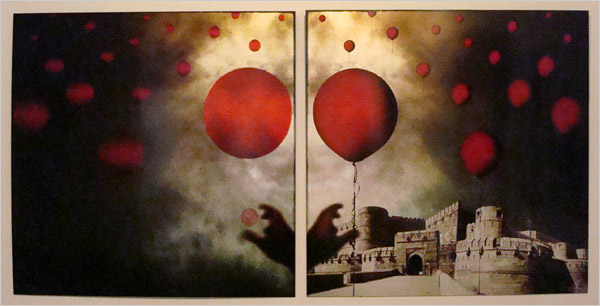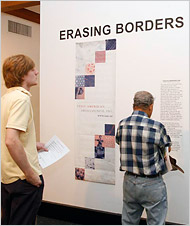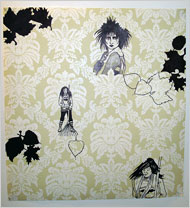Invitation
About the Exhibition
Exhibition Schedule
Curator
Statement of our Service
Sponsor Benefits
Press Release
Press Package
Photos
Reviews |
| Erasing Borders: Passport to Contemporary Indian Art Feb-June 2008 |
| |
Art Review
A Collection Born of Cultural Dislocation
NYTimes.com, July 13, 2008 |

The photograph “For Regret,” by Prince Varughese Thomas.
By BENJAMIN GENOCCHIO
Published: July 13, 2008
|
The extent of the Indian diaspora is worth remembering when viewing “Erasing Borders,” the Hammond Museum’s overstuffed exhibition of 63 works by 40 artists of Indian descent who are based in the United States.
|
In the Region
Long Island, Westchester, Connecticut and New Jersey
|

Michael Poolan
Works on display in “Erasing Borders” at the Hammond Museum in North Salem. |
| |

Shelly Bahl’s “Karma Chameleon #1,”
ink on wallpaper. |
About 20 million South Asians settled in other parts of the world in the last century, and more than 2 million live in the United States, according to the 2000 census, many of them in the New York metropolitan area, which has one of the fastest-growing Asian-American populations in the country. And if submissions for the Hammond’s exhibition are any guide, the number of South Asian artists is also increasing. The exhibition’s curator, Vijay Kumar, received applications from more than 250 artists from around the country.
“Erasing Borders” attempts to give an overview of artists of the Indian diaspora. The exhibition is predictably varied in quality and style, the selection jumbling together artists of very different ages working in all kinds of artistic media. Still, the artists seem to cluster around certain themes or stylistic trends, suggesting a commonality of experience, along with shared concerns and beliefs.
Cultural dislocation often fosters new hybrid modes of expression among artists of immigrant groups. This quality is especially prevalent here, with several artists combining traditional Indian imagery, ideas and subject matter with Western aesthetic values and forms. The painter Antonio Puri, for instance, infuses abstract expressionism with elements of Buddhist spirituality.
A similar approach - melding the modern and traditional - is illustrated in Prince Varughese Thomas’s photographs. Decorative imagery of bright red balloons appropriated from the Internet combine with a picturesque image of a Mogul fort in “For Regret,” a memorable photographic diptych showing here. It is an endearing marriage of high and low.
Other artists in the exhibition inject contemporary imagery into traditional Indian art forms. Especially popular is miniature painting, originally imported from Persia into India during the Mogul period. Indian miniatures provide the inspiration for works here by Siona Benjamin, Salma Arastu, Anna Indumati Bhushan, Samanta Batra Mehta, Pratima Naithani, Ela Shah and Shelly Bahl.
Some of these artists - especially Ms. Shah and Ms. Benjamin - have had their work shown in recent exhibitions in the New York metropolitan region. But many of them have not, and the decision to include a variety of these kinds of paintings, when the art form is currently undergoing a revival across South Asia, is welcome. It gives the exhibition contemporary art currency.
Ms. Bhushan’s watercolor works are exquisite. Jewel-like, with intense colors, they have an aura of preciousness about them, much like the real miniature paintings. And yet their subject matter - in this case, a pair of scantily clad women touching hands in a kind of dance pose - is somewhat ambiguous, even strange. The work has the vaguely uncanny look and feeling of a fairy tale.
Ms. Bahl’s “Karma Chameleon #1” packs a different punch. It is an ink drawing of punk-rock girls raking leaves, sharply delineated in heavy black ink against a background of floral wallpaper. It impresses for many reasons, not the least of which is that the artist brings the ghoulish and decorative into contiguous alignment. It also touches lightly on women’s work and the association with domesticity.
From the rest of the show - reams of painting, installation, sculpture and photography - it is hard to discern much in the way of general tendencies. But several figurative paintings give us a feeling for the importance of narrative in the work of artists of the Indian diaspora. Beauty and decoration play a role in their work, but these artists also want their paintings to tell a story.
Veru Narula’s “Kathak Dancers” is stealthily political. It is an oil painting of a group of three dancers performing against a surreal-looking landscape with a fiery red sky. Kathak is a classical dance from northern India and also the national dance of Pakistan. The link with Pakistan here is significant, for the dancers all wear gas masks. I read this painting as an allegory for the threat of war between the two countries, both of them now nuclear powers.
Several prints and drawings also stand out for their skill and sensitivity. Amina Ahmed’s technique used for charcoal drawings like “Root 2” dazzles. And though her mostly abstract subject matter feels a little repetitive, and arid of meaning, her works are charged with a certain tension and ambiguity that keeps you looking and thinking about them.
Finally, Fariba Alam’s ceramic tiles near the show’s entrance are clever, revelatory and lovely. The artist has transferred onto the surface of the tiles photographic imagery of a woman looking up at the ceiling of a building, perhaps a mosque, that is covered in decorative tiles in floral patterns and Islamic calligraphy. There is a riveting, visual newness to this work, making it a highlight of the show.
“Erasing Borders,” Hammond Museum and Japanese Stroll Garden, 28 Deveau Road, North Salem, through Sept. 6. Information: (914) 669-5033 or www.hammondmuseum.org.
|
http://www.nytimes.com/2008/07/13/nyregion/nyregionspecial2/13artswe.html?_r=2&scp=1&sq=A+Collection+
Born+of+Cultural+Dislocation+&st=nyt&oref=slogin&oref=slogin |
| |
|

